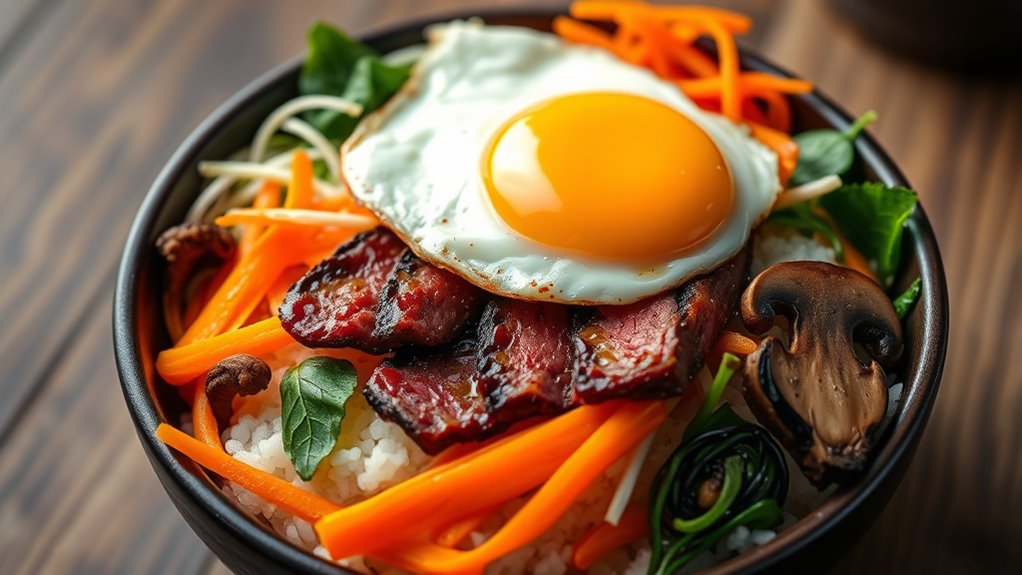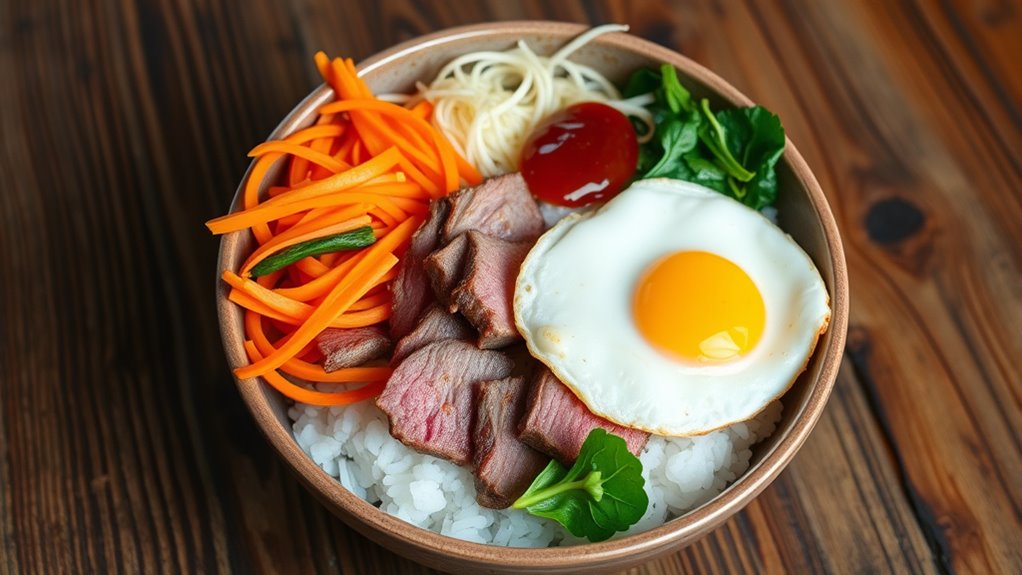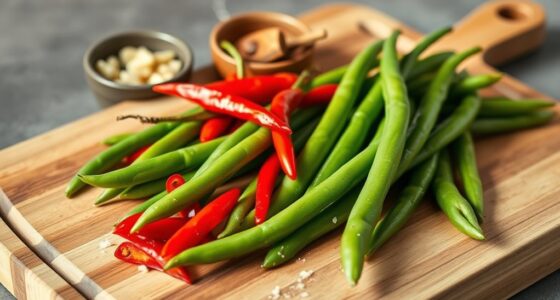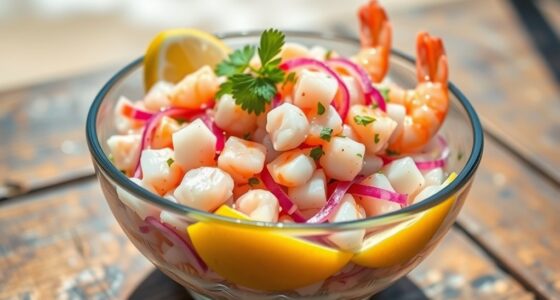Korean bibimbap is a vibrant and hearty rice bowl filled with fresh, colorful vegetables, tender meat, and a spicy gochujang sauce that embodies Korea’s rich culinary tradition. It highlights harmony and balance, with each ingredient representing different elements of life. Variations across regions feature local ingredients like seafood or seasoned beans. Exploring more about bibimbap reveals how this dish reflects Korea’s culture, history, and regional pride—so keep going to discover its full story.
Key Takeaways
- Bibimbap is a traditional Korean mixed rice dish featuring colorful vegetables, protein, and spicy gochujang sauce.
- It symbolizes harmony, balance, and unity, reflecting Korean cultural values through its diverse ingredients.
- Regional variations include Jeonju’s rich flavors, seafood on Jeju Island, and diverse vegetable combinations across Korea.
- The dish is commonly served as a communal meal, highlighting Korean social and culinary traditions.
- Globally popular, Bibimbap showcases Korea’s culinary diversity and adaptability with regional ingredients and styles.

Korean bibimbap is a vibrant and nutritious dish that combines rice, fresh vegetables, protein, and a flavorful gochujang sauce. It’s more than just a meal; it’s a reflection of Korean culture and history. When you sit down to enjoy bibimbap, you’re experiencing a dish that holds deep cultural significance. Traditionally, it symbolizes harmony and balance, with each ingredient representing different elements of life. The colorful array of vegetables and toppings isn’t just for aesthetics—it embodies the idea of unity among diverse components. This dish has played a role in Korean society for centuries, often served during special occasions or communal gatherings, emphasizing togetherness. Over time, its cultural importance has only grown, making bibimbap a symbol of Korean identity both domestically and internationally. Additionally, the dish’s regional variations showcase the diverse local ingredients and culinary traditions across Korea.
Regionally, bibimbap varies widely across Korea, showcasing local ingredients and culinary traditions. For example, in Jeonju, the birthplace of bibimbap, the dish is famous for its rich, hearty flavors and use of local ingredients like seasoned bean sprouts, spinach, and shredded beef. Here, the rice is often topped with a fried egg and served with a generous dollop of gochujang, creating a perfect balance of spice and richness. In contrast, in the southern regions, you might find bibimbap with more seafood or different vegetable choices, reflecting the local harvests. Jeju Island, known for its fresh seafood, incorporates octopus or other seafood into the mix, giving the dish a distinctive regional twist. In Seoul, the capital, bibimbap tends to be more standardized, often found in restaurants catering to tourists, but still retaining regional influences in ingredient choices. These variations highlight how adaptable and deeply rooted bibimbap is within Korean culinary traditions.
As you explore different versions of bibimbap, you’ll notice how regional variations tell stories of local climate, geography, and history. Each bowl offers a unique taste of its place of origin, making the dish both a culinary experience and a cultural journey. Whether you prefer the hearty, vegetable-rich styles of Jeonju or the seafood-infused versions from Jeju, you’re participating in a tradition that celebrates diversity and regional pride. This adaptability is part of what makes bibimbap so beloved worldwide. It’s not just a meal; it’s a cultural tapestry, woven with ingredients and techniques passed down through generations, each region adding its own flavor. So, when you enjoy bibimbap, you’re savoring a dish that’s deeply meaningful, beautifully diverse, and eternally connected to Korea’s rich cultural heritage. Cultural significance and regional pride are central themes reflected in every bowl of bibimbap.
Frequently Asked Questions
What Are the Origins of Bibimbap?
You might find it fascinating that bibimbap’s historical origins trace back over a thousand years in Korea, blending royal cuisine and agricultural traditions. Its cultural significance lies in representing harmony and balance, often reflecting the five elements. You’ll notice how its colorful ingredients symbolize unity, making it more than just a meal. This dish embodies Korea’s rich history and cultural identity, connecting generations through its vibrant, meaningful presentation.
How Do You Prepare Authentic Bibimbap at Home?
To prepare authentic bibimbap at home, start by cooking short-grain rice and preparing vegetables like spinach, carrots, and zucchini with quick sautéing or blanching. Use beef, chicken, or tofu as your protein, and top with a fried egg. For cooking tips, arrange ingredients neatly and add gochujang for flavor. Ingredient substitutions like bean sprouts or mushrooms work well if needed. Mix everything thoroughly before serving for an authentic experience.
What Are Common Vegetarian Variations of Bibimbap?
Imagine a vibrant garden in every bite—this is your vegetarian bibimbap. You can swap meat for crispy tofu, symbolizing strength and resilience. Fill your bowl with a colorful vegetable medley—spinach, carrots, zucchini—that represent harmony and balance. Drizzle with gochujang or sesame oil, stirring together to evoke warmth. This dish becomes a nourishing, soulful symphony, celebrating the beauty in plant-based simplicity and the essence of fresh ingredients.
How Do You Make the Spicy Gochujang Sauce?
To make spicy gochujang sauce, start by mixing 2-3 tablespoons of gochujang with a teaspoon of sesame oil, a splash of rice vinegar, and a teaspoon of honey or sugar for flavor enhancement. Add minced garlic and grated ginger if you like extra depth. Stir well until smooth, then taste and adjust the heat or sweetness. This spicy gochujang adds bold flavor to your dishes and enhances their overall taste.
Are There Regional Differences in Bibimbap Recipes?
Yes, bibimbap recipes vary regionally, reflecting different flavor profiles and ingredient variations. In Jeonju, you might find a richer, more savory style with local ingredients like beef and soybean sprout sprouts. Meanwhile, Jeju offers a seafood twist, using fresh fish and unique vegetables. These regional differences allow you to experience diverse taste profiles, making each bibimbap version unique to its area’s culinary traditions.
Conclusion
Now that you know how to make and enjoy bibimbap, imagine yourself savoring a colorful bowl filled with fresh vegetables, tender meat, and a perfectly fried egg on top. Did you know that Korea consumes over 2.5 million tons of rice annually? That means every day, millions of people start their day with this nutritious, vibrant dish. So next time you crave a wholesome meal, remember bibimbap’s rich history and delicious variety—it’s truly a bowl of Korea’s soul.









